- Joined
- Oct 9, 2007
- Messages
- 47,657 (7.43/day)
- Location
- Dublin, Ireland
| System Name | RBMK-1000 |
|---|---|
| Processor | AMD Ryzen 7 5700G |
| Motherboard | Gigabyte B550 AORUS Elite V2 |
| Cooling | DeepCool Gammax L240 V2 |
| Memory | 2x 16GB DDR4-3200 |
| Video Card(s) | Galax RTX 4070 Ti EX |
| Storage | Samsung 990 1TB |
| Display(s) | BenQ 1440p 60 Hz 27-inch |
| Case | Corsair Carbide 100R |
| Audio Device(s) | ASUS SupremeFX S1220A |
| Power Supply | Cooler Master MWE Gold 650W |
| Mouse | ASUS ROG Strix Impact |
| Keyboard | Gamdias Hermes E2 |
| Software | Windows 11 Pro |
As the computer enthusiast community gears up for Nehalem November, with reports suggesting a series of product launches for both Intel's Core i7 processors and compatible motherboards, Industry observer PC Online.cn have already published an in-depth review of the Core i7 940 2.93 GHz processor. The processor is based on the Bloomfield core, and essentially the Nehalem architecture that has been making news for over an year now. PC Online went right to the heart of the matter, evaluating the 192-bit wide (tri-channel) memory interface, and the advantage of HyperThreading on four physical cores. In the tests, the 2.93 GHz Bloomfield chip was pitted against a Core 2 Extreme QX9770 operating at both its reference speed of 3.20 GHz, and underclocked to 2.93 GHz, so a clock to clock comparison could be brought about.
The evaluation found that the performance increments tri-channel offers over dual-channel memory, in real world applications and games, are just about insignificant. Super Pi Mod 1.4 shows only a fractional lead for tri-channel over dual-channel, and the trend continued with Everest Memory Benchmark. On the brighter side, the integrated memory controller does offer improvements over the previous generation setup, with the northbridge handling memory. Even in games such as Call of Duty 4 and Crysis, tri-channel memory did not shine.
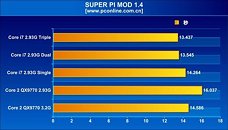
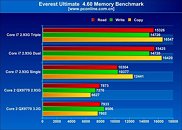
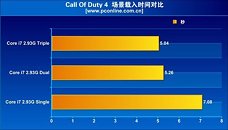
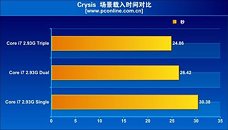
As for the other architectural change, simultaneous multi-threading, that makes its comeback on the desktop scene with the Bloomfield processors offering as many as eight available logical processors for the operating system to talk to, it appears to be a mixed bag, in terms of performance. The architecture did provide massive boosts in WinRAR and Cinebench tests Across tests, enabling SMT brought in performance increments of roughly 10~20% with general benchmarks that included Cinebench, WinRAR, TMPGEnc, and Fritz Chess. With 3DMark Vantage, SMT provided a very significant boost to the scores, with about 25% increments. It didn't do the same, to current generation games such as Call of Duty 4, World in Conflict and Company of Heroes. What's more, the games didn't seem to benefit from Bloomfield in the first place. The QX9770 underclocked at 2.93 GHz, outperformed i7 940, both with and without SMT, in some games.
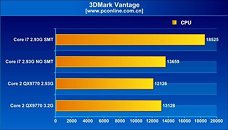
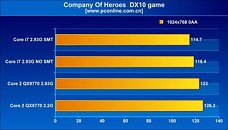
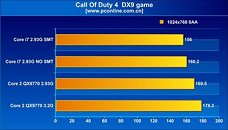
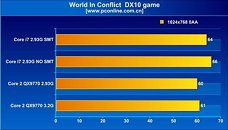
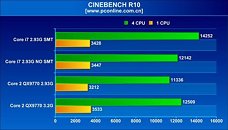
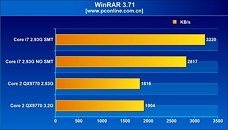
View at TechPowerUp Main Site
The evaluation found that the performance increments tri-channel offers over dual-channel memory, in real world applications and games, are just about insignificant. Super Pi Mod 1.4 shows only a fractional lead for tri-channel over dual-channel, and the trend continued with Everest Memory Benchmark. On the brighter side, the integrated memory controller does offer improvements over the previous generation setup, with the northbridge handling memory. Even in games such as Call of Duty 4 and Crysis, tri-channel memory did not shine.




As for the other architectural change, simultaneous multi-threading, that makes its comeback on the desktop scene with the Bloomfield processors offering as many as eight available logical processors for the operating system to talk to, it appears to be a mixed bag, in terms of performance. The architecture did provide massive boosts in WinRAR and Cinebench tests Across tests, enabling SMT brought in performance increments of roughly 10~20% with general benchmarks that included Cinebench, WinRAR, TMPGEnc, and Fritz Chess. With 3DMark Vantage, SMT provided a very significant boost to the scores, with about 25% increments. It didn't do the same, to current generation games such as Call of Duty 4, World in Conflict and Company of Heroes. What's more, the games didn't seem to benefit from Bloomfield in the first place. The QX9770 underclocked at 2.93 GHz, outperformed i7 940, both with and without SMT, in some games.






View at TechPowerUp Main Site






 Forget about QDR, I'm stupid, I forgot you still have rising and falling edges like in Intel's Quad pumped FSB. I still fail to see how you could do 8 ops per cycle though.
Forget about QDR, I'm stupid, I forgot you still have rising and falling edges like in Intel's Quad pumped FSB. I still fail to see how you could do 8 ops per cycle though.
 Quad Pumping is done using 2 clocks with 90º phase difference.
Quad Pumping is done using 2 clocks with 90º phase difference.